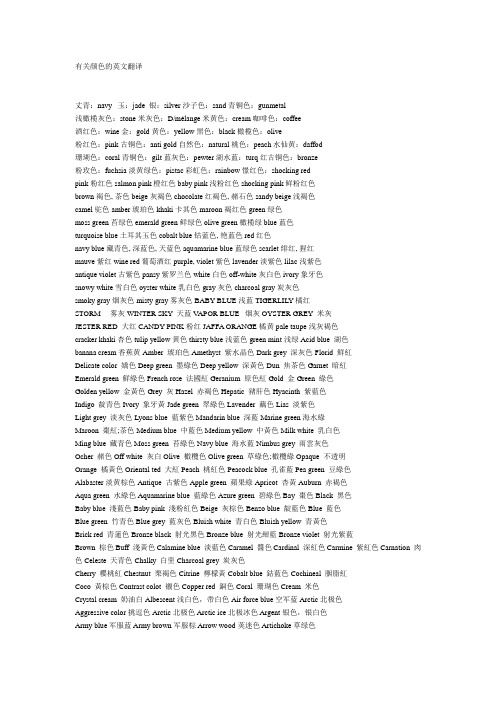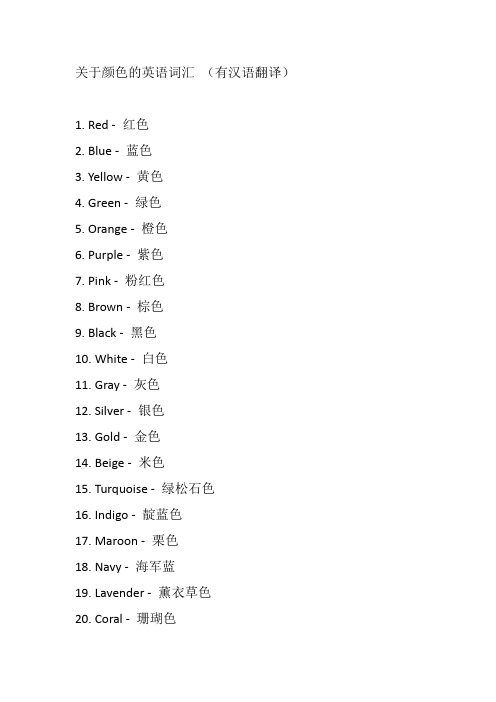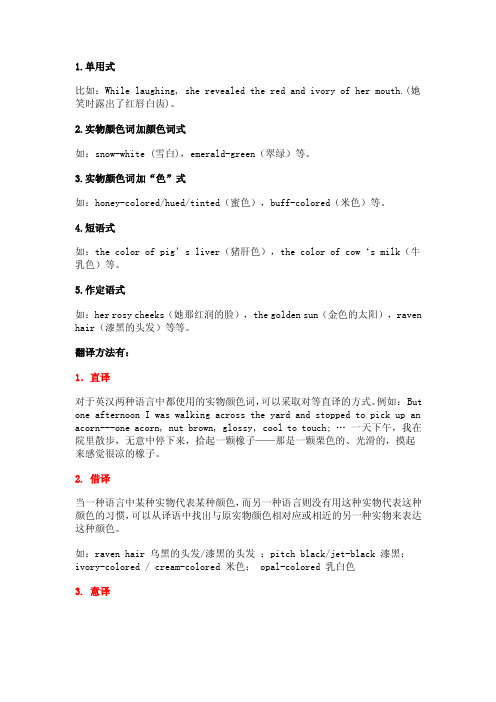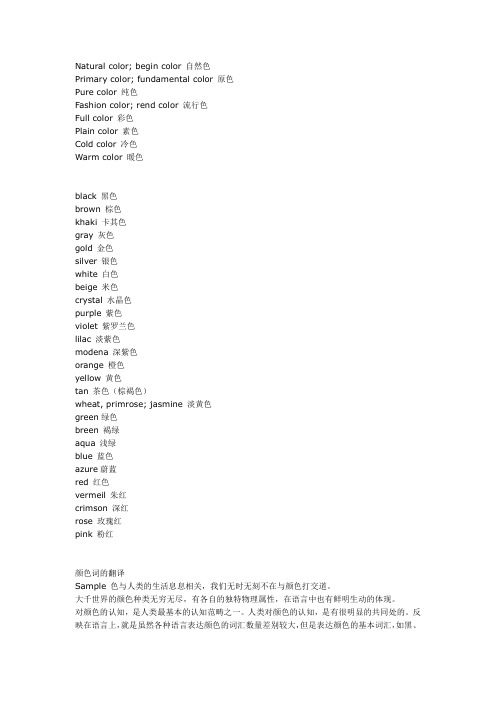关于各种颜色的翻译方法
各种颜色的翻译

玉:jade银:silver沙子色:sand青铜色:gunmetal浅橄榄灰色:stone米灰色:D/melange米黄色:cream咖啡色:coffee酒红色:wine金:gold黄色:yellow黑色:black橄榄色:olive粉红色:pink古铜色:anti gold自然色:natural桃色:peach水仙黄:daffod珊瑚色:coral青铜色:gilt蓝灰色:pewter湖水蓝:turq红古铜色:bronze粉玫色:fuchsia淡黄绿色:pistac彩虹色:rainbow憬红色:shocking red pink 粉红色salmon pink 橙红色baby pink 浅粉红色shocking pink 鲜粉红色brown 褐色, 茶色beige 灰褐色chocolate 红褐色, 赭石色sandy beige 浅褐色camel 驼色amber 琥珀色khaki 卡其色maroon 褐红色green 绿色moss green 苔绿色emerald green 鲜绿色olive green 橄榄绿turquoise blue 土耳其玉色cobalt blue 钴蓝色, 艳蓝色navy blue 藏青色, 深蓝色, 天蓝色aquamarine blue 蓝绿色red 红色scarlet 绯红, 猩红mauve 紫红wine red 葡萄酒红purple, violet 紫色lavender 淡紫色lilac 浅紫色antique violet 古紫色pansy 紫罗兰色white 白色off-white 灰白色ivory 象牙色snowy white 雪白色oyster white 乳白色gray 灰色charcoal gray 炭灰色smoky gray 烟灰色misty gray 雾灰色BABY BLUE 浅蓝TIGERLILY 橘红STORM 雾灰WINTER SKY 天蓝VAPOR BLUE 烟灰OYSTER GREY 米灰JESTER RED 大红CANDY PINK 粉红JAFFA ORANGE 橘黄pale taupe 浅灰褐色cracker khaki 杏色tulip yellow 黄色thirsty blue 浅蓝色green mint 浅绿banana cream 香蕉黄Acid blue 湖色Amber 琥珀色Amethyst 紫水晶色Antique 古紫色Apple green 苹果绿Apricot 杏黄Aqua green 水绿色Aquamarine blue 蓝绿色Auburn 赤褐色Azure green 碧绿色Bay 枣色Baby blue 浅蓝色Baby pink 浅粉红色Beige 灰棕色Benzo blue 靛蓝色Black 黑色Blue 蓝色Blue green 竹青色Blue grey 蓝灰色Bluish white 青白色Bluish yellow 青黄色Brick red 青莲色Bronze black 射光黑色Bronze blue 射光绀蓝Bronze violet 射光紫蓝Brown 棕色Buff 浅黄色Calamine blue 淡蓝色Caramel 酱色Cardinal 深红色Carmine 紫红色Carnation 肉色Celeste 天青色Chalky 白垩Charcoal grey 炭灰色Cherry 樱桃红Chestnut 栗褐色Citrine 柠檬黄Cobalt blue 钴蓝色Cochineal 胭脂红Coco 黄棕色Contrast colot 衬色Copper red 铜色Coral 珊瑚色Cream 米色Crystal cream 奶油白Dark green 深绿色Dark grey 深灰色Delicate color 娇色Deep green 墨绿色Deep yellow 深黄色Dun 焦茶色Emerald green 鲜绿色Florid 鲜红French rose 法国红Garnet 暗红Geranium 原色红Gold 金Golden yellow 金黄色Green 绿色Grey 灰Hazel 赤褐色Hepatic 猪肝色Hyacinth 紫蓝色Indigo 靛青色Ivory 象牙黄Jade green 翠绿色Lavender 藕色Lias 淡紫色Light grey 淡灰色Lyons blue 蓝紫色Mandarin blue 深蓝Marine green 海水绿Maroon 枣红;茶色Medium blue 中蓝色Medium yellow 中黄色Milk white 乳白色Ming blue 藏青色Moss green 苔绿色Navy blue 海水蓝Nimbus grey 雨云灰色Ocher 赭色Off white 灰白Olive 橄榄色Olive green 草绿色;橄榄绿Opaque 不透明Orange 橘黄色Oriental ted 大红Peach 桃红色Peacock blue 孔雀蓝Pea green 豆绿色Pied 杂色Pink 粉红色Pitch black 深黑色Protective color 保护色Prussian blue 普鲁士蓝Purple 紫色Purple bronze 紫铜色Red 红Reddish 淡红Reddish yellow 浓黄Rich color 浓色Rose 玫瑰红Royal blue 宝蓝色Rust brown 鼻烟色Sallow 苍黄Salmon 橙红Sandy 淡茶色Sap green 暗绿色Scarlet 绯色Sepia 棕黑色Shade 颜色深浅Shocking pink 鲜粉红Silver 银色Sky blue 天蓝Slate grey 鼠灰色Smoky grey 雾灰色Snow white 雪白Soft color 嫩色Sorrel 红棕色Tan 浅棕色Tapestry red 咖啡色Tawny 黄褐色Translucent 半透明Transparent 透明Turquoise 蓝绿色Turquoise blue 土耳其玉色Ultramarine 青蓝色Ultramarine blue 群青Umber 浓茶色Verdigris color 铜绿色Vermilion 桔红;朱砂红Violet 紫罗兰色White 白色Wine red 葡萄红Yellow 黄色York yellow 蛋黄色amber 琥珀色antique violet 古紫色antiquewhite 古董白aqua 浅绿色aquamarine 碧绿色azure 天蓝色baby pink 浅粉红色beige 米色bisque 橘黄色black 黑色blanchedalmond 白杏色blue 蓝色blueviolet 紫罗兰色brown 棕色burlywood 实木色cadetblue 军蓝色camel 驼色charcoal gray 炭灰色chartreuse 黄绿色chocolate 巧克力色cobalt blue 艳蓝色coral 珊瑚色。
什么颜色英语翻译

201 j4 不锈钢化学成分1. 介绍201 j4 不锈钢的基本概念201 j4 不锈钢, 是一种高锰、高氮奥氏体不锈钢,具有良好的耐腐蚀性能和加工性能。
它是一种具有高强度和高硬度的不锈钢材料,常用于制造家用器具、建筑装饰、厨房设备等。
2. 201 j4 不锈钢的主要化学成分201 j4 不锈钢的化学成分主要包括:- 镍(Ni):3.5%-5.5%- 铬(Cr):16%-18%- 锰(Mn):5.5%-7.5%- 钼(Mo):1%-3%- 硅(Si):1%- 氮(N):0.15%-0.28%- 碳(C):小于0.15%- 磷(P):小于0.06%- 硫(S):小于0.03%3. 201 j4 不锈钢的成分特点3.1 镍(Ni)和铬(Cr)是不锈钢中的主要合金元素,能够提高不锈钢的耐腐蚀性和抗氧化性。
3.2 锰(Mn)和氮(N)的含量较高,能够增加不锈钢的强度和硬度,提高其耐磨性和耐磨性。
3.3 钼(Mo)在201 j4 不锈钢中的添加可以提高其耐腐蚀性能,特别是在一些特殊腐蚀介质下具有良好的耐蚀性。
3.4 硅(Si)的添加可以改善不锈钢的热加工性能和塑性。
4. 201 j4 不锈钢的适用范围201 j4 不锈钢由于其优异的机械性能和耐腐蚀性能,常用于制造以下产品:4.1 厨房设备:如锅具、刀具、餐具等。
4.2 建筑装饰:如不锈钢管、不锈钢板、不锈钢扣件等。
4.3 家用器具:如洗衣机桶、冰箱门、微波炉等。
4.4 其他:如化工设备、汽车零件、电子产品外壳等。
5. 结语201 j4 不锈钢以其合理的化学成分和优良的性能得到了广泛的应用,为人们的生活和工业生产提供了重要的材料基础,相信在不久的将来,201 j4 不锈钢一定会有更加广阔的发展前景。
201 j4 不锈钢作为一种高锰、高氮奥氏体不锈钢,具有良好的耐腐蚀性能和加工性能。
它是一种具有高强度和高硬度的不锈钢材料,常用于制造家用器具、建筑装饰、厨房设备等。
有关颜色的英文翻译

有关颜色的英文翻译丈青:navy 玉:jade 银:silver 沙子色:sand 青铜色:gunmetal浅橄榄灰色:stone 米灰色:D/mélange 米黄色:cream 咖啡色:coffee酒红色:wine 金:gold 黄色:yellow 黑色:black 橄榄色:olive粉红色:pink 古铜色:anti gold 自然色:natural 桃色:peach水仙黄:daffod珊瑚色:coral 青铜色:gilt蓝灰色:pewter湖水蓝:turq红古铜色:bronze粉玫色:fuchsia 淡黄绿色:pistac彩虹色:rainbow憬红色:shocking redpink 粉红色 salmon pink 橙红色 baby pink 浅粉红色 shocking pink 鲜粉红色brown 褐色, 茶色 beige 灰褐色 chocolate 红褐色, 赭石色 sandy beige 浅褐色camel 驼色 amber 琥珀色 khaki 卡其色 maroon 褐红色 green 绿色moss green 苔绿色 emerald green 鲜绿色 olive green 橄榄绿 blue 蓝色turquoise blue 土耳其玉色 cobalt blue 钴蓝色, 艳蓝色 red 红色navy blue 藏青色, 深蓝色, 天蓝色 aquamarine blue 蓝绿色 scarlet 绯红, 猩红mauve 紫红 wine red 葡萄酒红 purple, violet 紫色 lavender 淡紫色 lilac 浅紫色antique violet 古紫色 pansy 紫罗兰色 white 白色 off-white 灰白色 ivory 象牙色snowy white 雪白色 oyster white 乳白色 gray 灰色 charcoal gray 炭灰色smoky gray 烟灰色 misty gray 雾灰色 BABY BLUE 浅蓝TIGERLILY 橘红STORM 雾灰WINTER SKY 天蓝V APOR BLUE 烟灰OYSTER GREY 米灰JESTER RED 大红CANDY PINK 粉红JAFFA ORANGE 橘黄pale taupe 浅灰褐色cracker khaki 杏色tulip yellow 黄色thirsty blue 浅蓝色green mint 浅绿Acid blue 湖色banana cream 香蕉黄Amber 琥珀色Amethyst 紫水晶色Dark grey 深灰色Florid 鮮紅Delicate color 嬌色Deep green 墨綠色Deep yellow 深黃色Dun 焦茶色Garnet 暗紅Emerald green 鮮綠色French rose 法國紅Geranium 原色紅Gold 金Green 綠色Golden yellow 金黃色Grey 灰Hazel 赤褐色Hepatic 豬肝色Hyacinth 紫藍色Indigo 靛青色Ivory 象牙黃Jade green 翠綠色Lavender 藕色Lias 淡紫色Light grey 淡灰色Lyons blue 藍紫色Mandarin blue 深藍Marine green 海水綠Maroon 棗紅;茶色Medium blue 中藍色Medium yellow 中黃色Milk white 乳白色Ming blue 藏青色Moss green 苔綠色Navy blue 海水藍Nimbus grey 雨雲灰色Ocher 赭色Off white 灰白Olive 橄欖色Olive green 草綠色;橄欖綠Opaque 不透明Orange 橘黃色Oriental ted 大紅Peach 桃紅色Peacock blue 孔雀藍Pea green 豆綠色Alabaster 淡黄棕色Antique 古紫色Apple green 蘋果綠Apricot 杏黃Auburn 赤褐色Aqua green 水綠色Aquamarine blue 藍綠色Azure green 碧綠色Bay 棗色Black 黑色Baby blue 淺藍色Baby pink 淺粉紅色Beige 灰棕色Benzo blue 靛藍色Blue 藍色Blue green 竹青色Blue grey 藍灰色Bluish white 青白色Bluish yellow 青黃色Brick red 青蓮色Bronze black 射光黑色Bronze blue 射光紺藍Bronze violet 射光紫藍Brown 棕色Buff 淺黃色Calamine blue 淡藍色Caramel 醬色Cardinal 深紅色Carmine 紫紅色Carnation 肉色Celeste 天青色Chalky 白堊Charcoal grey 炭灰色Cherry 櫻桃紅Chestnut 栗褐色Citrine 檸檬黃Cobalt blue 鈷藍色Cochineal 胭脂紅Coco 黃棕色Contrast colot 襯色Copper red 銅色Coral 珊瑚色Cream 米色Crystal cream 奶油白Albescent 浅白色,带白色Air force blue 空军蓝Arctic 北极色Aggressive color 挑逗色Arctic 北极色 Arctic ice 北极冰色 Argent 银色,银白色Army blue 军服蓝 Army brown 军服棕 Arrow wood 荚迷色 Artichoke 草绿色Artichoke green 洋蓟绿 Ash 浅灰色 Ash grey 浅灰色 Ashy 灰白色的,苍白的Asparagus green 芦笋绿 Aspen gold 山杨黄 Aspen green 山杨绿 Assorted colors 杂色Asphalt 柏油色,沥青色 Aster purple 紫菀色 Aubergine 茄皮色,紫红色Auburn 猪肝色,茶褐色 Aurora (orange)朝霞桔(红橙色) Auroral 玫瑰红Aurora pink 晨曦玫瑰红 Aurora red 朝霞Australian ruby 澳大利亚红宝石Autumn 灰黄色 Autumn blonde 金秋色(黄棕色) Autumn tints 秋色 Awn 金黄色Average 中间色 Azure 天蓝色,淡青色,天青色 Azure blue 中蓝,天蓝Azure green 碧绿色,天蓝色 Azurite blue 石青蓝(灰绿蓝色) Baby pink 淡粉红Baby blue 淡蓝色,婴儿蓝 Background color 背景色,底色 Bad color 印色不佳Bad white 白色不白 Balas ruby 玫红尖晶宝石 Balsam 蟹绿 Bice 蓝色Balsam green 青灰色,凤仙花绿 Baltic 波罗的海色 Bamboo 竹黄、浅灰黄色Banana 香蕉黄,草黄色,浅奶油Blue green 青绿(色相) Bluish green 带蓝色绿Bice blue 石青蓝(灰绿蓝色) Bice green 孔雀石绿 Birch (grey) 桦木色,浅灰棕色Bison 深咖啡色 Bisque 深褐色,藕荷色,灰黄色 Bister, bistre 棕色,深褐色Bitter chocolate 深咖啡色Bittersweet 朱红色,橘红色 Bixin 胭脂树橙色Black 黑色 Black alkali 黑灰 Black amber 黑琥珀 Black ash 黑灰 Black dull 暗黑Black earth 土黑色 Black ink 黑墨水色 Blae 暗蓝色,灰蓝色 Blatic 湖绿Bleached apricot 淡杏色 Bleached aqua 漂白水,漂白水色 Blossom 花红色Blossom pink 淡粉红 Blue 青色,蓝色,天蓝色 Blue ashes 深灰蓝,潮蓝Blue atoll 珊瑚岛蓝 Blue-based color 蓝底色 Bluebell 风铃草蓝 Bluebird 青鸟蓝Blue black 墨蓝色,蓝黑色 Blue clear 鲜蓝色 Blue coral 蓝珊瑚色 Blue fog 雾蓝色Blue Danube 多瑙河蓝 Blue deep 暗蓝,深蓝 Blue fox 蓝狐色 Blue glass 蓝玻璃色Blue grass 蓝草地色 Blue green 青绿(色相) Blue grey 蓝灰色 Blue grotto 岩洞蓝Blue haza 蓝雾色 Blue indigo 靛蓝 Blue iris 蓝虹色 Bon-bon pink 粉红的,桃红色Blueing, bluing 上蓝剂,上蓝,发蓝Body color 不透明色,(物)体色Bold yellow 金黄色 Bombay brown 孟买褐 Bombastic shade 稻草色调 Breen 棕绿色Bone black 骨黑 Bone brown 骨棕色(暗棕色) Bone color 骨色 Boulder 圆石色Bone white 骨白色,淡灰黄色 Bordeaux (葡萄)酒红(暗紫红色) Bran 麸色Botanical color 植物色 Botticelli blue 灰蓝 Botticelli pink 明洋红 Brass 黄铜色Bottle green 瓶绿,深绿色 Bougainvillea 鲜艳紫红色 Brachioradialis 青苔色Brass beetle shade 黄铜甲虫色 Brazen 黄铜色的Breton red 暗红色 Brick red 红砖色Brick color 砖色,砖红色 Bridal rose 新娘玫瑰红 Bright azalea 鲜杜鹃色Bright blue 鲜蓝 Bright color 明亮色,鲜亮色 Bright gold 棕色 Bright red 鲜红,大红Bright green 翠青,翠绿 Bright herbaceous peony 鲜芍药红 Bright mauve 淡紫红色Bright rose 鲜玫瑰色 Bright sapphire blue 鲜宝蓝 Bright velvet 鲜艳紫色Brilliant blue 孔雀蓝,酞青 Brimstone 硫磺色 Bristol 淡宝蓝色,天蓝色Brindle 带深色斑纹的棕色,带深色斑纹的灰色 Bronze 古铜色 Bronze green 暗铜绿Bronze black 古铜黑色 Bronze blue 古铜绀蓝色。
关于颜色的英语词汇 (有汉语翻译)

关于颜色的英语词汇(有汉语翻译)1. Red -红色2. Blue -蓝色3. Yellow -黄色4. Green -绿色5. Orange -橙色6. Purple -紫色7. Pink -粉红色8. Brown -棕色9. Black -黑色10. White -白色11. Gray -灰色12. Silver -银色13. Gold -金色14. Beige -米色15. Turquoise -绿松石色16. Indigo -靛蓝色17. Maroon -栗色18. Navy -海军蓝19. Lavender -薰衣草色20. Coral -珊瑚色22. Magenta -品红色23. Olive -橄榄色24. Cyan -青色25. Peach -桃色26. Salmon -鲑鱼色27. Sky blue -天蓝色28. Lime green -酸橙绿29. Plum -李子色30. Mauve -紫红色31. Emerald -祖母绿32. Coral -珊瑚色33. Ruby -红宝石色34. Tiffany blue -蒂芙尼蓝35. Charcoal gray -炭灰色36. Mustard -芥末色37. Moss green -苔藓绿38. Chocolate brown -巧克力色39. Baby pink -浅粉色40. Steel blue -钢蓝色41. Ivory -象牙白42. Brick red -砖红色44. Turmeric yellow -姜黄色45. Coral pink -珊瑚粉色46. Mint green -薄荷绿47. Ash gray -灰白色48. Royal blue -皇家蓝49. Sand beige -沙棕色50. Teal blue -湖蓝色色。
颜色的翻译

black tea black and blue brown sugar red sugar brown bread black cloth purple wine black hair
红茶 青一块紫一块 红糖 黄糖 黑面包 青布 红葡萄酒 青丝
Mr. White is a very white man. He was looking rather green the other day. He has been feeling blue today. When I saw him, he was in a brown mood. I hope he'll soon be in the pink again. 布朗先生是一位忠实可靠的人。那天他脸色不好,近 来感到闷闷不乐。 我见到他的时候,他显得心事重重。 我希望他早点振作起来。 Variously viewed, the ducks change subtly in colour from ruby to yellow to violet. 鸭子身上不可捉摸的颜色因人们观察角度的改变而忽 红,忽黄,忽紫。
red tip on stock market 指股票市场的最新情报 to be shown the red card 被解雇;被开除 to catch sb. red/take sb. red-handed 当场抓获
red light
危险信号
a red letter day
纪念日,大喜的日子
on red alert see the red light red wine red ruin red battle red sky
1. Red 红色 • 红色在中国文化中象征着吉祥、喜庆。在英语中也可看到红色代 表喜庆的例子:
各种颜色的英语翻译

丈青:navy玉:jade银:silver沙子色:sand青铜色:gunmetal浅橄榄灰色:stone米灰色:D/melange米黄色:cream咖啡色:coffee酒红色:wine金:gold黄色:yellow黑色:black橄榄色:olive粉红色:pink古铜色:anti gold自然色:natural桃色:peach水仙黄:daffod珊瑚色:coral青铜色:gilt蓝灰色:pewter湖水蓝:turq红古铜色:bronze粉玫色:fuchsia淡黄绿色:pistac彩虹色:rainbow憬红色:shocking redpink 粉红色salmon pink 橙红色baby pink 浅粉红色shocking pink 鲜粉红色brown 褐色, 茶色beige 灰褐色chocolate 红褐色, 赭石色sandy beige 浅褐色camel 驼色amber 琥珀色khaki 卡其色maroon 褐红色green 绿色moss green 苔绿色emerald green 鲜绿色olive green 橄榄绿blue 蓝色turquoise blue 土耳其玉色cobalt blue 钴蓝色, 艳蓝色navy blue 藏青色, 深蓝色, 天蓝色aquamarine blue 蓝绿色red 红色scarlet 绯红, 猩红mauve 紫红wine red 葡萄酒红purple, violet 紫色lavender 淡紫色lilac 浅紫色antique violet 古紫色pansy 紫罗兰色white 白色off-white 灰白色ivory 象牙色snowy white 雪白色oyster white 乳白色gray 灰色charcoal gray 炭灰色smoky gray 烟灰色misty gray 雾灰色BABY BLUE 浅蓝TIGERLILY 橘红STORM 雾灰WINTER SKY 天蓝VAPOR BLUE 烟灰OYSTER GREY 米灰JESTER RED 大红CANDY PINK 粉红JAFFA ORANGE 橘黄pale taupe 浅灰褐色cracker khaki 杏色tulip yellow 黄色thirsty blue 浅蓝色green mint 浅绿banana cream 香蕉黄Acid blue 湖色Amber 琥珀色Amethyst 紫水晶色Antique 古紫色Apple green 苹果绿Apricot 杏黄Aqua green 水绿色Aquamarine blue 蓝绿色Auburn 赤褐色Azure green 碧绿色Bay 枣色Baby blue 浅蓝色Baby pink 浅粉红色Beige 灰棕色Benzo blue 靛蓝色Black 黑色Blue 蓝色Blue green 竹青色Blue grey 蓝灰色Bluish white 青白色Bluish yellow 青黄色Brick red 青莲色Bronze black 射光黑色Bronze blue 射光绀蓝Bronze violet 射光紫蓝Brown 棕色Buff 浅黄色Calamine blue 淡蓝色Caramel 酱色Cardinal 深红色Carmine 紫红色Carnation 肉色Celeste 天青色Chalky 白垩Charcoal grey 炭灰色Cherry 樱桃红Chestnut 栗褐色Citrine 柠檬黄Cobalt blue 钴蓝色Cochineal 胭脂红Coco 黄棕色Contrast colot 衬色Copper red 铜色Coral 珊瑚色Cream 米色Crystal cream 奶油白Dark green 深绿色Dark grey 深灰色Delicate color 娇色Deep green 墨绿色Deep yellow 深黄色Dun 焦茶色Emerald green 鲜绿色Florid 鲜红French rose 法国红Garnet 暗红Geranium 原色红Gold 金Golden yellow 金黄色Green 绿色Grey 灰Hazel 赤褐色Hepatic 猪肝色Hyacinth 紫蓝色Indigo 靛青色Ivory 象牙黄Jade green 翠绿色Lavender 藕色Lias 淡紫色Light grey 淡灰色Lyons blue 蓝紫色Mandarin blue 深蓝Marine green 海水绿Maroon 枣红;茶色Medium blue 中蓝色Medium yellow 中黄色Milk white 乳白色Ming blue 藏青色Moss green 苔绿色Navy blue 海水蓝Nimbus grey 雨云灰色Ocher 赭色Off white 灰白Olive 橄榄色Olive green 草绿色;橄榄绿Opaque 不透明Orange 橘黄色Oriental ted 大红Peach 桃红色Peacock blue 孔雀蓝Pea green 豆绿色Pied 杂色Pink 粉红色Pitch black 深黑色Protective color 保护色Prussian blue 普鲁士蓝Purple 紫色Purple bronze 紫铜色。
关于各种颜色的翻译方法

1.单用式比如:While laughi ng, she revealed the red and ivory of he r mouth.(她笑时露出了红唇白齿)。
2.实物颜色词加颜色词式如:sno w-white (雪白),emerald-green(翠绿)等。
3.实物颜色词加“色”式如:honey-colore d/hued/tinted(蜜色),bu ff-colored(米色)等。
4.短语式如:the color of pi g’s liver(猪肝色),the c olo r of cow‘s milk(牛乳色)等。
5.作定语式如:her r osy cheeks(她那红润的脸),t he golden sun(金色的太阳),raven hair(漆黑的头发)等等。
翻译方法有:1.直译对于英汉两种语言中都使用的实物颜色词,可以采取对等直译的方式。
例如: But one aft ernoon I was walking across the yard and stopped to pick upan acorn---one acorn, nut brown, glossy, cool to touch; … 一天下午,我在院里散步,无意中停下来,拾起一颗橡子——那是一颗栗色的、光滑的,摸起来感觉很凉的橡子。
2. 借译当一种语言中某种实物代表某种颜色,而另一种语言则没有用这种实物代表这种颜色的习惯,可以从译语中找出与原实物颜色相对应或相近的另一种实物来表达这种颜色。
如:raven h air 乌黑的头发/漆黑的头发;pit ch black/jet-black 漆黑;ivory-colored / c ream-colored 米色; opa l-colored 乳白色3. 意译对于那些在一种语言中常用,而在另一种语言中不常用或不使用的实物颜色词在译语里面又找不到可以借用表达这种颜色的实物颜色词,最好采取意译即使用基本颜色词的方法。
各类颜色中英文对照

Natural color; begin color 自然色Primary color; fundamental color 原色Pure color 纯色Fashion color; rend color 流行色Full color 彩色Plain color 素色Cold color 冷色Warm color 暖色black 黑色brown 棕色khaki 卡其色gray 灰色gold 金色silver 银色white 白色beige 米色crystal 水晶色purple 紫色violet 紫罗兰色lilac 淡紫色modena 深紫色orange 橙色yellow 黄色tan 茶色(棕褐色)wheat, primrose; jasmine 淡黄色green绿色breen 褐绿aqua 浅绿blue 蓝色azure蔚蓝red 红色vermeil 朱红crimson 深红rose 玫瑰红pink 粉红颜色词的翻译Sample 色与人类的生活息息相关,我们无时无刻不在与颜色打交道。
大千世界的颜色种类无穷无尽,有各自的独特物理属性,在语言中也有鲜明生动的体现。
对颜色的认知,是人类最基本的认知范畴之一。
人类对颜色的认知,是有很明显的共同处的。
反映在语言上,就是虽然各种语言表达颜色的词汇数量差别较大,但是表达颜色的基本词汇,如黑、白、红、黄、绿、蓝等,在很多语言中都是相通的,是非常一致的。
不过,由于各民族文化风俗,地理位置,历史传统,宗教信仰,民族心理,思维习惯等方面差异,颜色词语有时有表现出各民族独特的“个性”,带有显著的文化烙印。
这就使得颜色词语的翻译,可以采用不同的方法。
下面,先让我们来比较一下英汉两种语言中一些常见颜色词汇的异同。
A. red(红色)无论是在英语国家还是在中国,红色往往与庆祝活动或喜庆日子有关。
因为日历中,这些日子常用红色字体。
因此,red letter day:指的是“纪念日”或“喜庆的日子”。
- 1、下载文档前请自行甄别文档内容的完整性,平台不提供额外的编辑、内容补充、找答案等附加服务。
- 2、"仅部分预览"的文档,不可在线预览部分如存在完整性等问题,可反馈申请退款(可完整预览的文档不适用该条件!)。
- 3、如文档侵犯您的权益,请联系客服反馈,我们会尽快为您处理(人工客服工作时间:9:00-18:30)。
1.单用式比如:While laughing, she revealed the red and ivory of her mouth.(她笑时露出了红唇白齿)。
2.实物颜色词加颜色词式如:snow-white (雪白),emerald-green(翠绿)等。
3.实物颜色词加“色”式如:honey-colored/hued/tinted(蜜色),buff-colored(米色)等。
4.短语式如:the color of pig’s liver(猪肝色),the color of cow‘s m ilk(牛乳色)等。
5.作定语式如:her rosy cheeks(她那红润的脸),the golden sun(金色的太阳),raven hair(漆黑的头发)等等。
翻译方法有:1.直译对于英汉两种语言中都使用的实物颜色词,可以采取对等直译的方式。
例如: But one afternoon I was walking across the yard and stopped to pick up an acorn---one acorn, nut brown, glossy, cool to to uch; … 一天下午,我在院里散步,无意中停下来,拾起一颗橡子——那是一颗栗色的、光滑的,摸起来感觉很凉的橡子。
2. 借译当一种语言中某种实物代表某种颜色,而另一种语言则没有用这种实物代表这种颜色的习惯,可以从译语中找出与原实物颜色相对应或相近的另一种实物来表达这种颜色。
如:raven hair 乌黑的头发/漆黑的头发;pitch black/jet-black 漆黑;ivory-colored / cream-colored 米色; opal-colored 乳白色3. 意译对于那些在一种语言中常用,而在另一种语言中不常用或不使用的实物颜色词在译语里面又找不到可以借用表达这种颜色的实物颜色词,最好采取意译即使用基本颜色词的方法。
如:…small features, very fair; flaxen ringlets, or rather golden, hanging loosely on her delicate neck…细巧的脸蛋,白皙的皮肤,淡黄色的卷发——也许不如说是金黄色来得恰当——松松地批垂在她那细嫩的脖子上…又如:mulberry 深紫红色lobster 鲜红色cherry lips 鲜红的嘴唇rosy cheeks 红润的面颊要想准确而生动地运用各种颜色词把原文中色彩斑斓的世界重新展现在读者面前,使读者有身临其境之感,译者的确需要认真"察言观色",努力再现原文中的色彩。
遇到词汇空白和文化鸿沟时,要采取灵活的补救措施,使原文与译文相协调,使读者真正欣赏原作的色彩和意境。
一般说来,颜色词有以下几种译法:A. 把英语颜色词译成与之相应的汉语颜色词。
如果英语颜色词与汉语颜色词在词义上相同,就可采用这种直译的方法。
例如:(1) The sun was dropping behind the farthest mountain, and the valleys were purple with something deeper than aster. 夕阳已渐渐沉没在远山的背后,壑谷间一片紫蔼,颜色比紫菀还浓。
(2)His arms and legs were thickly smeared with calamine lotion dried to a chalky white. 他四肢上涂得厚厚的炉甘石液已干成粉白色。
(3)The very dust was scorched brown, and something quivered in the atmosphere as if the air itself was panting. 连那尘土都被炙烤成褐色;大气中似乎也有什么东西在颤抖,仿佛空气本身也在气喘吁吁。
(4)The clear, sharp cloven Carrara mountains sent up their steadfast flame of marble summit into amber sky. 轮廓分明的卡拉拉山把永恒不变的火焰似的大理石山顶插入琥珀色的天空。
(5)The leafless trees, that against the leaden sky now revealed more fully the wonderful beauty and intricacies of their branches. 那叶儿落尽的树木,映衬着铅灰色的天空,此刻显得更加枝丫交错,姿态万千。
B.改换英语颜色词。
如一种颜色在两种语言中分别被不同的颜色词所指称,而直译会导致读者不正确的联想或是不为译入语的读者所接受,这时可改换颜色词,使之符合译入语的表达习惯。
例如:(1) The floor was covered with ochre-colored sawdust, trampled here and there into mud. 地上全是黄褐色的木屑,到处都给踩成泥糊糊的了。
(2) The sun shining on her glossy hair, gave it a metallic luster, and it was difficult to say what was the color , dark bronze or black. 阳光照在她光泽的头发上,给它涂上一层金属似的光彩。
很难说出它究竟是什么颜色,是深褐色,还是黑色。
(3) Lightness, rapidity, nimbleness, grace and rich apparel all belong to the humming-bird. The emerald, the ruby, and the topaz gleam upon its dress. 蜂鸟具有轻盈、敏捷、灵活、优雅以及羽毛绚丽等一切妙处。
它那翠绿的、鲜红的、嫩黄色的羽毛闪闪发光。
(4)His face became blue with cold. 他的脸冻得发青。
(5)She dressed in a very short creamy skirt that day. 那天她穿着一条很短的米色裙子。
C.原文中无颜色词,译文中增加颜色词。
有时译文可根据具体语境添增色彩词以突出色彩,加强译文的感染力。
(1)And over all these, set close against the golden hair and burning cheek of lady and knight is that untroubled and sacred sky. 在这一切之上,同贵夫人和骑士金色头发和红润面颊相映衬的是一片蔚蓝的天空。
(2)He didn't try in vain. 他没有白干。
(3)Her eyes became moist. 她眼圈红了。
(4)It is like a windfall, like a Godsend, like an unexpected piece of luck. 它像飞来的吉庆,像天降洪福,像意外红运。
D.原文颜色词有象征意义或意义有所引申,一般采用意译灵活处理。
例如:(1) You look blue today. What's wrong with you? 你今天看起来闷闷不乐,出了什么事?(2) He is green with jealousy. 他醋意大发。
(3) He is a blue-blooded man . 他出生贵族。
(4)Her story immediately reminded me of a Chinese saying"The young beautiful lady will always be star-crossed." 听了有关她的故事,我立刻想到中国的一句俗语;"红颜薄命".颜色与人类的生活息息相关,我们我们无时无刻不在与颜色打交道。
大千世界的颜色种类无穷无尽,有各自的独特物理属性,在语言中也有鲜明生动的体现。
对颜色的认知,是人类最基本的认知范畴之一。
人类对颜色的认知,是有很明显的共同处的。
发映在语言上,就是虽然各种语言表达颜色的词汇数量差别较大,但是表达颜色的基本词汇,如黑、白、红、黄、绿、蓝等,在很多语言中都是相通的,是非常一致的。
不过,由于各民族文化风俗,地理位置,历史传统,宗教信仰,民族心理,思维习惯等方面差异,颜色词语有时有表现出各民族独特的“个性”,带有显著的文化烙印。
这就使得颜色词语的翻译,可以采用不同的方法。
下面,先让我们来比较一下英汉两种语言中一些常见颜色词汇的异同。
A. red(红色)无论是在英语国家还是在中国,红色往往与庆祝活动或喜庆日子有关。
因为日历中,这些日子常用红色字体。
因此,red letter day:指的是“纪念日”或“喜庆的日子”。
红色还指“负债”或“亏损”,因为人们总是用红笔登记负数。
于是就有了这些词组:red figure:赤字red ink:赤字in the red:亏损red-ink entry:赤字分录red balance:赤字差额除此之外,还有如?red cent:一分钱;red gold:纯金;red tip on stock market:指股票市场的最新情报汉语中常用的带“红”字的词语,翻译成英语,可不一定用“red”。
例如:红糖:brown sugar红茶:black tea红榜:honour roll红豆:love pea红运:good luck红利:dividend红事:weddingred wine:红酒red ruin:火灾red battle:血战red sky:彩霞B. black(黑色)在英语中经常有“不好的”、“坏的”、“邪恶的”这种意味。
例如:black money:黑钱(指来源不正当而且没有向政府报税的钱)black market:黑市交易或黑市(意为暗中进行政府禁止买卖的商品或外汇的交易,或指进行违法的投机市场);由此派生出black market price:黑市价格另外,英语中,和红色墨水是记帐时的意思相反,黑色还可表示盈利。
例如:black figure / in the black:盈利、赚钱、顺差又如black figure nation:国际收支顺差国interest in the black:应收利息C. blue(蓝色)在英语中通常表示不快乐、忧郁的情绪。
